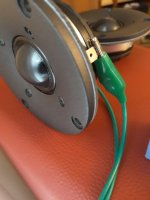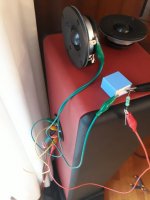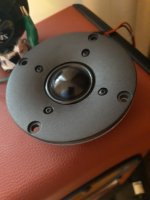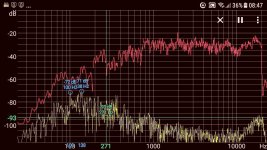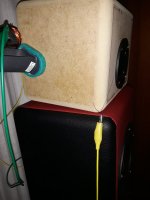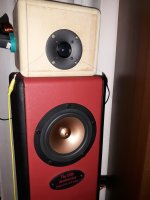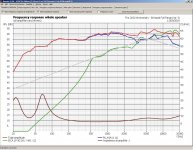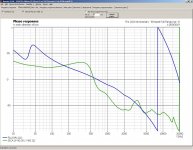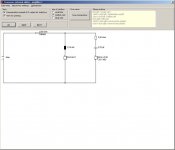(part 2 ..continue..)
It has been about thirty years since in the TOP AUDIO of Milan, by chance, when passing through a demonstration hall, I was suddenly astonished and amazed by the sound of the monstrous Dynaudio's Consequence. This made me literary approach the Danish house trying to snatch the secrets of such musicality and neutrality, which I discovered were common to all its loudspeakers in production. Surely there were two factors: the primarily use of first-order crossover filters with very low cuts thanks to the use of low resonance tweeters and extended band woofers, and, then, the unusual reversed vertical array of drive units (tweeter below) that allowed to time-align the drivers naturally without having to set back the speakers.
Since then, I have always built speakers with first-order filters with very satisfactory results before switching to the full-range sound, the latter being the only ones that allowed greater tonal neutrality.
The benefit of a first-order crossover is that they are electrically coherent in phase, that is, all signals at all frequencies are 90 ° out of phase. From here, the electrical and acoustical relationship coincide only if the acoustic centers of the speakers are in exact alignment in the vertical plane.
A driver used with a first-order crossover has to exhibit extremely good performance, I would say two octaves and half beyond the specified crossover point; i.e., in a two-way speaker with a crossing point of 2.8 kHz, a tweeter must be able to handle signals as low as 700 Hz (after the fundamental resonance), and a woofer must be able to handle signals as high as 11.2 kHz (before cone breakup modes).
This led to the research and purchase for my louspeakers of a tweeter with very low resonant frequency, power at least equal to Pluvia11 (nominal 45W / max 90W), equal electrical impedance (8 ohm) and a with sensitivity +3/+6dB higher (>>88dB), letting me able to tune the tweeter filter with only two components but including a series resistor; if the tweeter had the same sensitivity, the resistance could not have been included, greatly limiting the very important and foundamental session of filter ear calibration.
In addition, the cost and quality had to be comparable to those of Pluvia Eleven.
It was not an easy choice, especially from catalog. Thus, I discovered an Italian company, undeservedly little known, that builds excellent speakers with high efficiency: this is SICA, LP 90.28/N92TW, 8 ohm, 94.4dB, 50W nominal power, 1.1-inch dome and with a resonant frequency of only 600Hz!
(end part 2)
It has been about thirty years since in the TOP AUDIO of Milan, by chance, when passing through a demonstration hall, I was suddenly astonished and amazed by the sound of the monstrous Dynaudio's Consequence. This made me literary approach the Danish house trying to snatch the secrets of such musicality and neutrality, which I discovered were common to all its loudspeakers in production. Surely there were two factors: the primarily use of first-order crossover filters with very low cuts thanks to the use of low resonance tweeters and extended band woofers, and, then, the unusual reversed vertical array of drive units (tweeter below) that allowed to time-align the drivers naturally without having to set back the speakers.
Since then, I have always built speakers with first-order filters with very satisfactory results before switching to the full-range sound, the latter being the only ones that allowed greater tonal neutrality.
The benefit of a first-order crossover is that they are electrically coherent in phase, that is, all signals at all frequencies are 90 ° out of phase. From here, the electrical and acoustical relationship coincide only if the acoustic centers of the speakers are in exact alignment in the vertical plane.
A driver used with a first-order crossover has to exhibit extremely good performance, I would say two octaves and half beyond the specified crossover point; i.e., in a two-way speaker with a crossing point of 2.8 kHz, a tweeter must be able to handle signals as low as 700 Hz (after the fundamental resonance), and a woofer must be able to handle signals as high as 11.2 kHz (before cone breakup modes).
This led to the research and purchase for my louspeakers of a tweeter with very low resonant frequency, power at least equal to Pluvia11 (nominal 45W / max 90W), equal electrical impedance (8 ohm) and a with sensitivity +3/+6dB higher (>>88dB), letting me able to tune the tweeter filter with only two components but including a series resistor; if the tweeter had the same sensitivity, the resistance could not have been included, greatly limiting the very important and foundamental session of filter ear calibration.
In addition, the cost and quality had to be comparable to those of Pluvia Eleven.
It was not an easy choice, especially from catalog. Thus, I discovered an Italian company, undeservedly little known, that builds excellent speakers with high efficiency: this is SICA, LP 90.28/N92TW, 8 ohm, 94.4dB, 50W nominal power, 1.1-inch dome and with a resonant frequency of only 600Hz!
(end part 2)
Attachments
Last edited:
I think it might be worth pointing out that the above commentary is not quite complete.
-Symmetrical 1st order does indeed sum flat @ 90 degrees phase shift. If that is taken as the sole benefit (assuming it is in fact a benefit), then 3rd order also shares it, with the option of 270 degrees apart and reduced sensitivity to physical offset. Still plenty of that, but reduced.
-Drive units used with 1st order electrical filters do indeed require a very wide linear BW, and 2 octaves to either side of the crossover is a good ROT. This is not, however, exclusive to power handling or a self resonant frequency (e.g. Fs) but also in terms of its nominal flat response; in effect it's a vector sum so mechanical and electrical rolloffs are additive & if the drive unit is itself rolling off 1st order just below / above the XO frequency and you add a 1st order electrical high / low pass there, then you've got a 2nd order acoustical crossover. And so on. This is further affected by actual on-baffle response.
-Drive units do not require an equal impedance to be used in a multiway and there is little advantage in their being so.
-Power handling in tweeters is typically given following IEC 268-5 practice & usually assumes a 2nd order Butterworth high pass filter at 2500Hz or an equivalent thereof. They cannot handle the power levels cited without said filtering (not if you want them to last long ).
).
-600Hz is low, albeit not startlingly so. The Sica does not appear to use ferrofluid damping judging by the impedance curve, so realistically speaking, a simplistic series cap is unlikely to cut it unless you're crossing at a rather high frequency; you'll need either a shunt resistor or Fs impedance LCR to flatten that & prevent excess power / distortion.
-Symmetrical 1st order does indeed sum flat @ 90 degrees phase shift. If that is taken as the sole benefit (assuming it is in fact a benefit), then 3rd order also shares it, with the option of 270 degrees apart and reduced sensitivity to physical offset. Still plenty of that, but reduced.
-Drive units used with 1st order electrical filters do indeed require a very wide linear BW, and 2 octaves to either side of the crossover is a good ROT. This is not, however, exclusive to power handling or a self resonant frequency (e.g. Fs) but also in terms of its nominal flat response; in effect it's a vector sum so mechanical and electrical rolloffs are additive & if the drive unit is itself rolling off 1st order just below / above the XO frequency and you add a 1st order electrical high / low pass there, then you've got a 2nd order acoustical crossover. And so on. This is further affected by actual on-baffle response.
-Drive units do not require an equal impedance to be used in a multiway and there is little advantage in their being so.
-Power handling in tweeters is typically given following IEC 268-5 practice & usually assumes a 2nd order Butterworth high pass filter at 2500Hz or an equivalent thereof. They cannot handle the power levels cited without said filtering (not if you want them to last long
-600Hz is low, albeit not startlingly so. The Sica does not appear to use ferrofluid damping judging by the impedance curve, so realistically speaking, a simplistic series cap is unlikely to cut it unless you're crossing at a rather high frequency; you'll need either a shunt resistor or Fs impedance LCR to flatten that & prevent excess power / distortion.
(part 3 ..continue..)
Hi Scott, thank you for your interest.
Since I want to maintain the sound signature of the fullrange (Pluvia11) and preserve as much as possible its natural emission of medium range, I don't want to filter it too much deeply: I wish just to mitigate and contain some break-up modes and enhance its high frequency response, thus I think 6dB/octave is enough.
In addition, a first-order filter has the most predictable response, and is affected less by impedance variations than higher orders.
I read somewhere that first-order are the most accurate in reproduction of transients: they are the only type that can successfully reproduce a square wave. All other orders treat a square wave into something almost unrecognizable (the clarinet waveform is essentially a square wave).
I will also align the acoustic centers of the speakers, causing the tweeter to move back a few millimeters and tilt it down with respect to the horizontal axis to optimize its temporal relationship with the full range, aligning it to the listening point.
Since the Pluvia 11 is already positioned perfectly perpendicular to the support surface, I have to tilt the tweeter a few degrees (3° or 4°) down so that both the tweeter and the full range are oriented towards the ear about 3-4 meters away. This has brought great benefits during both listening and measuring sessions, linearizing the response and improving the acustic image.
I wanted to avoid any loss due to additional holes, decrease in internal volume and displacement of the damping material of the current bass reflex box for Pluvia11, which has already been optimized during last year. This has implied building an additional external box and placing it over the current one, which allows adjusting phisical alignment and angle. It will also contain all the components of the crossover filter. To limit any form of distortion due to diffraction, the tweeter is placed at the same distance from the upper edge and the two sides of the box, which should have all rounded sides and, in any case, as close as possible to the woofer. That is why the tweeter appears asymmetric in the box.
To tune a loudspeaker crossover network I first need a good simulation program, a real measurement of the environment, but in general everything has to be calibrated by ear during several long sessions of comparative listening with varied musical genres.
Simulation programs require four precise curves for each driver, both response and phase, both acoustic and electrical (which are not easy to obtain; the Thiele and Small parameters are barely sufficient) and have to consider the environmental configuration and precise positions of the drivers and tilt. It is just a good start to avoid some rude mistakes. I'm using Boxsim 2.00, which is free, easy to use and one the most complete.
Regarding the measurements...well I'm using (unfortunately!) the microphone of my smartphone and the good free application "Specroid" with white noise and frequency sweep tracks.
Let us say that a first order filter in a 2-ways system use 3 components in total, inductor, resistor (for the tweeter) and capacitor and a third order filter uses seven components in total: 3 inductors, 1 resistor and 3 capacitors.
If we test the speaker starting from the outputs of the simulation program of the XO components values, maitaining just one component fixed (usually the largest inductor), and varying each of them up and down by 30% during the listening and measuring sessions, we will need to test and compare only 6 different combinations in a first order filter (aa,ab,ac,ba,bb,bc), but nearly 500 different combinations using a third order filter that is practically impossible. Therefore, only with a first order filter we will find an optimum for our ears.
In the end, today I'm filtering (with satisfactory results) with R=2.5 ohm (with a range between 1.8ohm and 3ohm), C=2.7uF (I'm trying 2.2uF too) and L =0.15mH. By math, using a first order resistive calculator, it means that I'm cutting over 5KHz, which is safe for the tweeter. The tweeter is inverted compared to the woofer.
All above three methods I'm using (simulation, live listening and measurements) are converging more or less to the same point (a part of the depression in the 10Khz area in the measurements).
At first I was afraid to modify my existing loudspeaker and switch back to a multi-way system after many years, at the moment the balance is excellent, the coverage of the high frequencies increased and the acoustic image was not compromised, I would say even improved.
(end part 3)
Hi Scott, thank you for your interest.
Since I want to maintain the sound signature of the fullrange (Pluvia11) and preserve as much as possible its natural emission of medium range, I don't want to filter it too much deeply: I wish just to mitigate and contain some break-up modes and enhance its high frequency response, thus I think 6dB/octave is enough.
In addition, a first-order filter has the most predictable response, and is affected less by impedance variations than higher orders.
I read somewhere that first-order are the most accurate in reproduction of transients: they are the only type that can successfully reproduce a square wave. All other orders treat a square wave into something almost unrecognizable (the clarinet waveform is essentially a square wave).
I will also align the acoustic centers of the speakers, causing the tweeter to move back a few millimeters and tilt it down with respect to the horizontal axis to optimize its temporal relationship with the full range, aligning it to the listening point.
Since the Pluvia 11 is already positioned perfectly perpendicular to the support surface, I have to tilt the tweeter a few degrees (3° or 4°) down so that both the tweeter and the full range are oriented towards the ear about 3-4 meters away. This has brought great benefits during both listening and measuring sessions, linearizing the response and improving the acustic image.
I wanted to avoid any loss due to additional holes, decrease in internal volume and displacement of the damping material of the current bass reflex box for Pluvia11, which has already been optimized during last year. This has implied building an additional external box and placing it over the current one, which allows adjusting phisical alignment and angle. It will also contain all the components of the crossover filter. To limit any form of distortion due to diffraction, the tweeter is placed at the same distance from the upper edge and the two sides of the box, which should have all rounded sides and, in any case, as close as possible to the woofer. That is why the tweeter appears asymmetric in the box.
To tune a loudspeaker crossover network I first need a good simulation program, a real measurement of the environment, but in general everything has to be calibrated by ear during several long sessions of comparative listening with varied musical genres.
Simulation programs require four precise curves for each driver, both response and phase, both acoustic and electrical (which are not easy to obtain; the Thiele and Small parameters are barely sufficient) and have to consider the environmental configuration and precise positions of the drivers and tilt. It is just a good start to avoid some rude mistakes. I'm using Boxsim 2.00, which is free, easy to use and one the most complete.
Regarding the measurements...well I'm using (unfortunately!) the microphone of my smartphone and the good free application "Specroid" with white noise and frequency sweep tracks.
Let us say that a first order filter in a 2-ways system use 3 components in total, inductor, resistor (for the tweeter) and capacitor and a third order filter uses seven components in total: 3 inductors, 1 resistor and 3 capacitors.
If we test the speaker starting from the outputs of the simulation program of the XO components values, maitaining just one component fixed (usually the largest inductor), and varying each of them up and down by 30% during the listening and measuring sessions, we will need to test and compare only 6 different combinations in a first order filter (aa,ab,ac,ba,bb,bc), but nearly 500 different combinations using a third order filter that is practically impossible. Therefore, only with a first order filter we will find an optimum for our ears.
In the end, today I'm filtering (with satisfactory results) with R=2.5 ohm (with a range between 1.8ohm and 3ohm), C=2.7uF (I'm trying 2.2uF too) and L =0.15mH. By math, using a first order resistive calculator, it means that I'm cutting over 5KHz, which is safe for the tweeter. The tweeter is inverted compared to the woofer.
All above three methods I'm using (simulation, live listening and measurements) are converging more or less to the same point (a part of the depression in the 10Khz area in the measurements).
At first I was afraid to modify my existing loudspeaker and switch back to a multi-way system after many years, at the moment the balance is excellent, the coverage of the high frequencies increased and the acoustic image was not compromised, I would say even improved.
(end part 3)
Attachments
In addition, a first-order filter has the most predictable response, and is affected less by impedance variations than higher orders.
Well, all filter orders are predictable in terms of their electrical & acoustical transfer functions; 1st order is however far more (not less) affected by response deviations due to the slow rolloffs involved. That's why, if you're aiming for 1st order acoustical slopes, the drivers need to have a massive flat frequency & impedance BW to either side of the target crossover frequency.
1st order series crossovers are indeed less vulnerable to impedance variations than other types, at least in terms of the electrical transfer functions, since the drivers are connected, and a change in impedance affects both high and low pass. The crossover frequency alters, but electrically speaking the transfer functions always sum flat. That doesn't necessarily carry over to the acoustical transfer functions, since this depends on the acoustic response of the drivers. This only applies to 1st order series crossovers; it does not apply to 1st order parallel crossovers or any other filter order whether a series or parallel circuit is used. See Series vs. Parallel Crossover Networks for more. This helps a little with power-handling, but it only goes so far.
I read somewhere that first-order are the most accurate in reproduction of transients: they are the only type that can successfully reproduce a square wave. All other orders treat a square wave into something almost unrecognizable (the clarinet waveform is essentially a square wave).
Up to a point this is true; the question then becomes whether the ability to reproduce square waves in a given system is worth any sacrifices made in polar response, distortion performance, frequency response linearity, etc. in order to achieve it. No fixed answer to that; we all have our different priorities.
To tune a loudspeaker crossover network I first need a good simulation program,
Plenty of those available.
a real measurement of the environment,
Ditto; lots of free software & inexpensive hardware for that.
but in general everything has to be calibrated by ear during several long sessions of comparative listening with varied musical genres.
I'd suggest 'adjusted to personal taste' rather than 'calibrated' -the human ear is a remarkable piece of biological engineering, but one thing it is not a good measurement device.
Simulation programs require four precise curves for each driver, both response and phase, both acoustic and electrical (which are not easy to obtain; the Thiele and Small parameters are barely sufficient)
At least four; preferably a good number of off-axis curves also for the horizontal and vertical; certainly out to at least 30 degrees off, since deviations over that angle have been demonstrated to impact tonality quite significantly, especially with higher crossover frequencies where there is an increased probability of the drivers having significantly different polar responses. T/S parameters are completely irrelevant for crossover design of course.
I'm using Boxsim 2.00, which is free, easy to use and one the most complete.
I have a copy myself. It's good; a little limited compared to VituixCAD & some others, but as an integrated suite it's certainly one of the better ones.
Regarding the measurements...well I'm using (unfortunately!) the microphone of my smartphone and the good free application "Specroid" with white noise and frequency sweep tracks.
Your 'phone is definitely better than nothing! I'd suggest that you'll find it worth investing in a reasonable calibrated USB microphone though. They're not ideal for driver design & development but they're invaluable for speaker setup & system / crossover design.
Let us say that a first order filter in a 2-ways system use 3 components in total, inductor, resistor (for the tweeter) and capacitor and a third order filter uses seven components in total: 3 inductors, 1 resistor and 3 capacitors.
If we test the speaker starting from the outputs of the simulation program of the XO components values, maitaining just one component fixed (usually the largest inductor), and varying each of them up and down by 30% during the listening and measuring sessions, we will need to test and compare only 6 different combinations in a first order filter (aa,ab,ac,ba,bb,bc), but nearly 500 different combinations using a third order filter that is practically impossible. Therefore, only with a first order filter we will find an optimum for our ears.
I'm afraid I can't quite follow that argument, other than I think you're saying there aren't as many components so there are less for you to alter. Which is certainly true. And ultimately if you're happy, that's what counts.
Last edited:
- Status
- This old topic is closed. If you want to reopen this topic, contact a moderator using the "Report Post" button.
